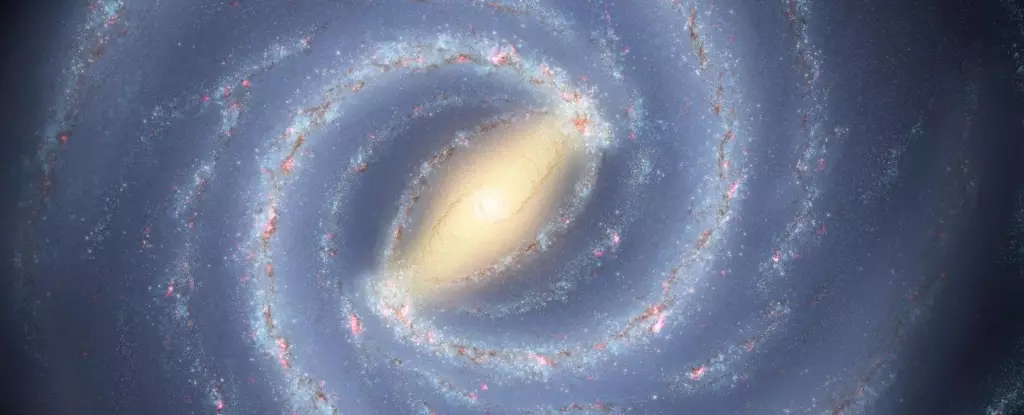The Milky Way galaxy has long been regarded as a pivotal reference point in astrophysics and cosmology, serving as an invaluable resource for understanding the formation and evolution of galaxies. Immersed within its spiral arms, astronomers leverage advanced observational technologies to analyze its intricate stellar population and gas dynamics with exceptional precision. By scrutinizing the Milky Way across diverse wavelengths, scientists can glean detailed insights into its characteristics that are often obscured in more distant galaxies. Nonetheless, recent revelations derived from comparative studies involving 101 similar galaxies prompt a reevaluation of how the Milky Way stands in relation to its cosmic peers.
To master the complexities of galaxy formation, astronomers can employ a fundamental educational technique: comparing and contrasting different entities within the same category. This approach is particularly potent in the context of astronomical surveys, which have enriched our understanding of various cosmic phenomena. Notable programs such as the Sloan Digital Sky Survey (SDSS), Two Micron All Sky Survey (2MASS), and the European Space Agency’s Gaia mission have collectively amassed vast datasets that illuminate the properties of galaxies beyond our own. A pivotal contribution to this field is the Satellites Around Galactic Analogs (SAGA) Survey, which focuses specifically on elucidating the role of dark matter in galactic structures. This investigation offers a unique perspective on the Milky Way’s birth and evolution as researchers delve into the properties of low-mass satellite galaxies orbiting Milky Way-like systems.
Central to the SAGA Survey’s investigations is the role of dark matter, an enigmatic substance that constitutes about 85% of the universe’s matter. Unlike baryonic matter, which forms stars and galaxies, dark matter’s properties remain elusive since it does not emit light and thus cannot be directly observed. However, its existence becomes apparent through its gravitational influences, which help shape the structures of galaxies. Research conducted by the SAGA Survey revealed comprehensive data on hundreds of satellite galaxies orbiting Milky Way-like systems, further enhancing our understanding of how dark matter halos function.
In analyzing various Milky Way analogues, the SAGA Survey identified a striking variance in the number of satellites per galaxy, ranging from none to as many as thirteen. This variability underlines the notion that the Milky Way is an outlier, challenging previously held assumptions about galaxy formation models. The SAGA data illuminates how the mass of the most massive satellite correlates with the total number of satellites in a galaxy—offering key insights into the dynamics of galaxy assembly.
Star formation rates (SFR) in satellite galaxies provide a crucial lens through which to examine galaxy evolution. The SAGA Survey’s findings indicate that while star formation persists in satellite galaxies, their proximity to a host galaxy affects their SFR levels. Notably, the data suggest that closer satellites experience inhibited star formation, potentially due to the gravitational pull exerted by the dark matter halo of the larger galaxy. This raises essential questions about how such environments influence the life cycles of satellite galaxies and their capability for star formation.
A deeper look reveals that in the Milky Way’s own satellites, only a couple—the Large and Small Magellanic Clouds—remain active in stellar formation. Within this context, the Milky Way stands apart with a unique blend of older, dormant satellites and younger, star-forming ones, creating an intriguing cosmic puzzle. Understanding the mechanisms at play in this scenario can provide a window into broader galactic evolution processes.
Concurrent with the empirical analysis, the SAGA data prompts advancements in theoretical modeling. A comparative study in the third data release aligns meticulously with computer simulations to better define the nature of quenching in satellite galaxies. Researchers successfully established a model for galaxies exhibiting masses equal to or less than 10^9 solar masses, guided by SAGA’s observations. This model adeptly reproduces the stellar mass functions and star formation rates within satellite systems, while also highlighting the need for further observational campaigns.
Ultimately, the SAGA Survey not only enhances our understanding of the universe’s vast expanse, but it also clarifies how the intricate dynamics of satellite galaxies fit into broader cosmic narratives. As researchers embark on future spectroscopic surveys, the aim remains to unravel the intricate interplay between dark matter, mass accretion, internal feedback mechanisms, and gas behavior within these celestial structures. Through this endeavor, the SAGA Survey stands as a crucial benchmark for deepening our grasp of galaxy formation and evolution across the cosmos.


Leave a Reply